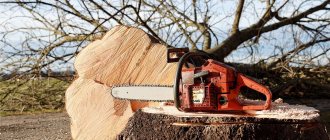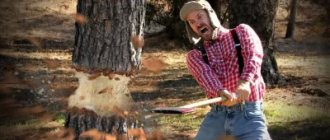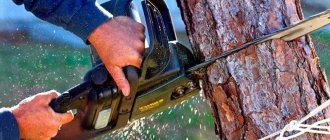Laws regulating logging
Tree felling is regulated by Land Law. This is a set of laws that spell out all the actions that can (or, on the contrary, cannot) be taken in relation to the land resources of our country.
Land Code (LC), clause 2, part 2, art. 40 states that the owner of a land plot trees planted (or growing spontaneously) that he does not need The same provision is recorded in the Civil Code (Civil Code) of the Russian Federation (Chapter 17, Art. 261).
If there is a dispute between neighbors, in which it is unclear on whose territory the tree to be cut down grows, it is worthwhile to survey the land plot, if this has not been done previously. Then, according to the law, it will be precisely established who is the owner of the disputed land and who has the right to cut down the tree.
Forestry legislation (Forest Code (LC), Article 16) provides for a number of exceptions in which trees cannot be cut down even on a dacha (gardening) plot. This provision applies if the land is not under the jurisdiction of a populated area, but in a forest fund. Article 6 of the LC states that forests can be located not only on the lands of the Forest Fund, but also on lands of other categories.
Despite the fact that, at first glance, according to paragraph 3 of Art. 261 of the Civil Code of the Russian Federation, the owner of a land plot has the right to use, at his own discretion, everything that is above and below the surface of this plot, but only unless otherwise provided by subsoil laws, forestry legislation, the law on the use of air space, other regulations and does not violate the rights of others persons
The right to cut down trees, even on your own property, depends on:
- availability of registered ownership of the land plot;
- category of land and type of its permitted use;
- type, age and condition of trees;
- other nuances.
According to Article 209.1 of the Civil Code of the Russian Federation, the owner of the plot has the right to independently dispose of his property, therefore only he can apply for permission.
If someone else applies for permission, then in order to consider his application, he must, at a minimum, have a power of attorney to represent the interests of the owner . Therefore, it is impossible to legally obtain a felling ticket or permission to cut down/cut down a tree located on someone else’s property, even if it is a significant nuisance.
The only exceptions are emergency and dangerous trees, however, even for them, only an authorized person can apply for permission. At the same time, the owner of the site may be either against cutting in general or against the use of certain methods, and even a representative of the local government will have to take his opinion into account.
Where to go to have an emergency tree cut down?
In order to cut down a tree in your yard, you must either ask local authorities for help or obtain the appropriate permission. Moreover, for each situation requiring the removal of vegetation from the site, there is its own procedure. And if in an apartment building they can cut down a tree for you, then you will have to deal with a tree on your own property yourself.
In an apartment building
In order to cut down a tree in the courtyard of an apartment building, you will need not only desire, but also a good reason. The following factors may be the reason:
- The tree is unsafe and poses a threat to residents;
- The tree has grown and poses a threat to communications;
- The tree has grown and is located too close to the house;
- The tree covers the windows, which creates insufficient light in the room;
- The tree spoils the appearance of the yard and most residents agree with you.
Information
In order to cut down a tree, you need to write an application to the HOA or management company responsible for your home. They will consider it from 10 days to a month, after which they will send you an official response. After this, a date will be set and tree cutting or pruning will be arranged. There is no need to pay for this, since the money comes from the general house care fund.
In a private house
Cutting down a tree on a summer cottage is a little more difficult. The conditions for carrying out the work remain the same as the statement above, but you will have to contact the dacha cooperative to which the site is assigned. If the site is not part of a cooperative, then your application will be accepted by the district government. But the tree itself will have to be cut at your own expense. If you are given a permit, you can remove the tree yourself, but in most cases you will need to hire a specialist. Fortunately, it is not too expensive - for one tree they will charge you about a thousand rubles.
Location on
Sometimes it happens that there is a tree on the acquired site that interferes with construction or planning. In this case, the procedure is slightly different from that described above. In order to fell a tree during construction, you need to collect the following package of documents:
- A statement to the authorities from the one who organizes the construction;
- Work permit;
- Document confirming land ownership;
- Plan of the site where trees will be marked;
- Conclusion of ecologists about the project;
- A copy of the felling agreement with a licensed organization;
- Acts of replanting plantings and cutting down trees;
- Landscaping or landscaping project.
Information
All these documents will need to be submitted to either the local cooperative, the district government, or the Housing Department.
Authorities regulating the issue
In most cases, such permits are issued by the Department of Natural Resources or the Nature Protection Department of the city administration, but there may be situations when its functions are performed by other departments, including the Department of Housing and Communal Services (HPU).
Most cities have their own procedure for issuing permits with a list of organizations that provide such services.
You can often order a permit through the “Single Window” service; in this case, the entire package of documents will be sent to the official who deals with these issues, and the land owner will not have to run around offices and ask who issues permits or logging tickets.
What trees can be removed from the site without consequences:
You can cut down trees on your property without permission if it is privately owned.
In this case, conditions must be met :
- There should be no rare or particularly valuable breeds.
- The site should not be adjacent to the forest or located nearby.
- The age of trees should not exceed a certain level (depending on the region and species).
- The number of trees removed should be small (1–2 pieces).
- Trees to be removed should not be located in habitats of endangered birds and animals listed in the Red Book.
- Removing trees will not cause negative reactions from neighbors or environmentalists.
- It is necessary to think through and implement a recovery plan.
If any of these points are not met, then it is advisable to obtain a permit before cutting or sawing. In this case, all responsibility will lie with those who issued the permit.
Trees that are valuable species are listed in FALH Order No. 513. This list contains 50 names of trees and shrubs that are prohibited from cutting down.
Here is just part of the list:
- Apricot
- Karelian birch
- Cherry
- Pear
- Toothed oak
- Japanese maple
- Lipa Maksimovich
- Small-fruited alder, rowan alder
- Manchurian nut - Juglans mandshurica Maxim.
- Whole-leaved fir, or Manchurian
- Bush pine
- Apple tree
- Woolly ash, etc.
There is no single document regulating the relationship between the owner of a plot of land and the trees growing on his plot. For example, all trees that are not fruit trees are a priori considered forest trees. And, if desired, of course, the Forest Code is watching over them. In this case, it does not matter at all whether these trees grow on forest lands or any other lands. The status of the trees remains the same.
Large trees can be marked on topographic maps, and also serve as landmarks for small aircraft.
Even if you manage to get rid of an unwanted tree unnoticed, if desired, the relevant services can prove its presence in the past using witness testimony, photographs, and even aerial photographs (for free-standing large trees).
In what cases is sleeping possible?
The reasons for cutting down or cutting down trees are different and you can read about them in this article Why trees are cut down.
Thinning is rarely used on trees located on private lands; in addition, they must be carried out by a qualified forester , otherwise, instead of benefit, this operation will only bring harm.
Therefore, the most common reasons are:
- interference with some work;
- changing the purpose of the site;
- danger created by the tree.
If a tree interferes with some work , but it is impossible to legally remove it without obtaining permission, then its cutting can be initiated either by the owner of the site during the preparation of documents for the upcoming work, or by the contractor during the execution of the work.
In any case, you must first submit documents, including a work plan and justification for the need to remove the tree, then pay for the examination and the costs of restoring the ecological balance. The same situation arises when the purpose of a land plot changes.
With emergency and dangerous trees, everything is somewhat different. After all, you first need to prove that the plant poses a danger and the only way to solve the problem is to cut it down or cut it down. Moreover, the check will be carried out taking into account the value of the plant, its age and other factors. Therefore, before submitting an application, you must clearly understand what signs allow you to classify a tree as dangerous or dangerous.
When is permission needed?
One of many examples in which permission to cut down is necessary: a tree grows not on the owner’s territory, but on adjacent land (belonging to the forest fund, municipality, or federal property). At the same time, it blocks the owner’s access to the property or interferes for some other reason.
To determine the possibility of sawing, it is necessary to conduct a land survey and go to the local government for permission. Another example: a private person acquires an area that is already planted with a large number of trees. But the owner wants to cut down some of them to make room for construction or a vegetable garden. This situation is very common. In this case, it is necessary to contact local authorities to obtain the necessary documents permitting cutting.
Who is responsible for the consequences of sawing or felling?
Tree cutting is a service, therefore all relations between the contractor and the performer are regulated by the Law of the Russian Federation of 02/07/1992 N 2300-1 “On the Protection of Consumer Rights”.
Until the contractor begins work within the agreed time frame, the owner of the site or the local administration .
Once the contractor has started work, all responsibility falls on him.
If, as a result of cutting or felling work, a part of a plant, such as a thick branch, damages someone's property or causes other harm, the full responsibility will lie with the contractor who failed to provide the necessary level of safety.
The only exception to this rule is associated with the involvement of “shabashniks” , that is, those who provide various services, but are not registered as an entrepreneur or are not a representative of any legal entity.
them accountable , because in the event of some incident they run away, and no legally binding contract is concluded with them.
The cost of services of officially registered enterprises and entrepreneurs is noticeably more expensive than the work of covens, this is due to:
- better quality equipment;
- higher level of training;
- guarantee of safety and quality of work.
Therefore, when contacting cobblers, it is necessary to take into account that responsibility for any damage caused during the process of cutting down a tree will lie with the customer.
All this fully applies to the local administration, which makes the decision to remove a particular tree.
If the work is performed by an officially registered legal entity , then responsibility for the consequences lies with it. If a tree is cut down by an administration employee or a “traditional craftsman” who is not registered as an entrepreneur, then all responsibility for the consequences lies with the administration.
The same situation applies to other land owners or organizations responsible for the condition of green spaces.
How to obtain permission to cut down trees
A felling ticket and (or) permission to replant trees and shrubs is issued by the environmental department of the administration of a city district or district. The application form is submitted in person or by contacting the MFC in accordance with the regulations established by local legislation.
The basic package will necessarily include documents confirming ownership of the plot.
This can be either an extract from the Unified State Register of Real Estate (USRN) or other documents.
The package also includes a statement in which the owner of the site describes the coordinates and purpose of the site, as well as the main parameters of the tree , that is:
- breed;
- dimensions;
- age;
- location on the site;
- reasons why felling is required.
In addition, the application must indicate an agreement to pay for an examination of the tree and payment of an environmental fee.
After this, a specialist will visit the site to assess the condition of the tree, as well as the degree of threat it poses. If the plant is not valuable or especially valuable, and also in cases where its age, and therefore its thickness, has not reached a certain value, then instead of a permit, the applicant will receive a notice that a permit is not required to remove this tree.
Most often this applies to fruit varieties, especially hybrid ones, as well as trees whose age does not exceed 30–50 years.
If suddenly a tree turns out to be valuable, then the specialist assesses the degree of threat it poses and the amount of expenses necessary to restore the green fund.
This requirement is based on Federal Law No. 7-FZ of January 10, 2002 “On Environmental Protection,” however, each region and large city, and often small towns, has its own procedure for calculating such fees, taking into account local factors.
Having made sure that all the data specified in the application is correct and the tree really interferes or poses a threat, the specialist will transfer the application and his conclusion on it to a special commission under the city or district administration. After the application is approved by the commission, the applicant is given a permit, which specifies the coordinates and address of the site and the location of the tree on it relative to other trees.
If several trees growing next to each other are intended to be cut down, then in addition to the permit, you must obtain a felling ticket, but there is a possibility that you will have to obtain one even for cutting down one tree.
After all, these issues are regulated by laws issued by the local government.
Having received permission, you need to find an enterprise or private entrepreneur who can do this work and enter into an agreement with him for the provision of services. After this, you must pay for the tree removal services, as well as the fees required by law, and submit all documents, including approval, to the Department of Environmental Management. Often, enterprises and entrepreneurs involved in tree removal independently obtain a permit and felling ticket for a small fee.
Who is responsible for damage caused by trees?
An emergency tree poses a serious danger , so it must be cut down in a timely manner. Moreover, responsibility for this lies primarily with the owner of the territory, because Article 1064 of the Civil Code of the Russian Federation says that the one who caused it must compensate for the harm caused, and not necessarily directly.
If this is a plant of valuable species , then if it falls, it will be possible to clearly establish the culprit only in court.
After all, on the one hand, the owner of the land is responsible for it, but on the other hand, no less responsibility lies with the city or district administration, because without its permission it is impossible to cut down a dangerous object.
The situation is the same in cases where a widely overgrown crown poses a threat to power lines or building elements (windows, roofs, etc.). After all, only mature trees can have such a crown, and most of them, regardless of the species, fall under the definition of a valuable resource , so the owner of the site cannot arbitrarily decide their fate.










